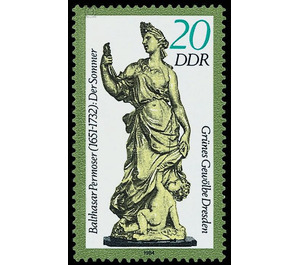Artworks from the Green Vault Dresden - Germany / German Democratic Republic 1984 - 20 Pfennig
Theme: Art & Culture
| Country | Germany / German Democratic Republic |
| Issue Date | 1984 |
| Face Value | 20.00 |
| Color | green |
| Perforation | K 14 and K 12 1/2: 13 |
| Printing Type | Squeegee and offset |
| Stamp Type | Postage stamp |
| Item Type | Stamp |
| Chronological Issue Number | 2648 |
| Chronological Chapter | GER-DDR |
| SID | 176155 |
| In 29 Wishlists | |
Works of art from the Green Vault Dresden The Department of Postal and Telecommunications of the German Democratic Republic publishes four multicolored special postage stamps with illustrations of works of art from the Green Vault Dresden. Special cancellation from October 23 to December 22 The Green Vault in Dresden The Green Vault, the treasury of the Saxon electors and kings, is the most important collection of preteos on the European continent. Designed from the outset as a public museum collection was established in the third decade of the 18th century according to the instructions of August the Strong in eight consecutive rooms of the Dresden Residenzschlosses. Most of the works of art assembled to form a new collection came from the Electoral Saxon Kunstkammer, founded in 1560, the Hofsilberkammer and the so-called "Geheimver Verwahrung", in which valuable objects of art were kept, and one of the original rooms of the Grünes Gewölbe. This vaulted, secure vault was painted green, and when the Treasury Museum was rebuilt, the name "Green Vault" was transferred to the entire collection. The equipment of the rooms was created with the participation of the most outstanding artists who worked in the residence. As a Gesamtkunstwerk, the Schatzkammer Museum was the result of the interaction of the most diverse arts in the service of an ingenious overall plan. Next to the kennel builder Pöppelmann, the architects Longuelune and Le Plat worked on the designs. Court sculptor Benjamin Thomas carved tables and consoles with his pupil and assistants Johann Joachim Kändler, the future master of Meissen porcelain sculpture. Court painters Christian Reinow and Martin Schnell painted entire room decorations , In addition to the unique goldsmith and jewelery works, the magnificent jewelery sets of the Saxon Kronschatz and Johann Melchior Dinglinger's large cabinet pieces, for which the Green Vault is world famous, count numerous works of art from other materials, such as rock crystal, amber, precious stones, glass, wood, bronze and ivory to the inventory of the Treasury Museum. The collection of ivory works was dedicated to the final installation of the Green Vault at the end of the 1820s, the ivory room, in which elaborately marbled room decorations, figurative ivory carvings and works of art made of precious materials are presented to the beholder on tables and presented in wall-filling arrangements on consoles. The works of Balthasar Permosers, of which the Green Vault has the most important collection of small sculptures, occupy an artistically outstanding position within the inventory of ivory carvings. Permoser, who was born in 1651 as the son of a farmer in Kammer near Otting in Chiemgau, received his education in Salzburg and Vienna and stayed in Italy since 1675. In 1689 he was called to court sculptor to Dresden. The cycle of the four seasons in the Green Vault - in distinction to other variants carved by Permoser variants of this series of figures called "The Dresden Seasons" - was created by Sigfried Asche 1685-1690. As a document says, the statuettes were handed over in 1714 to August the Strong. Since 1725 they are detectable in the inventories of the Green Vault. The allegories of the four seasons - compared in their individualization to the human age - symbolize the eternal cycle of becoming, being and passing away. The figurines, which are each about 22 cm high and have been developed from a tooth section, demonstrate the outstanding mastery of Permoser in the ivory carving art in the elegance of their movements and the richness of the rhythmic surfaces. We discover the figure figures comparable to small cabinet pieces in some of the sandstone sculptures of the Dresden Zwinger, whose architectural sculpture Permoser created his workshop about three decades after the creation of the "Dresden Seasons" and which made him the main master of the sculpture of the Augustan late Baroque in Dresden.


